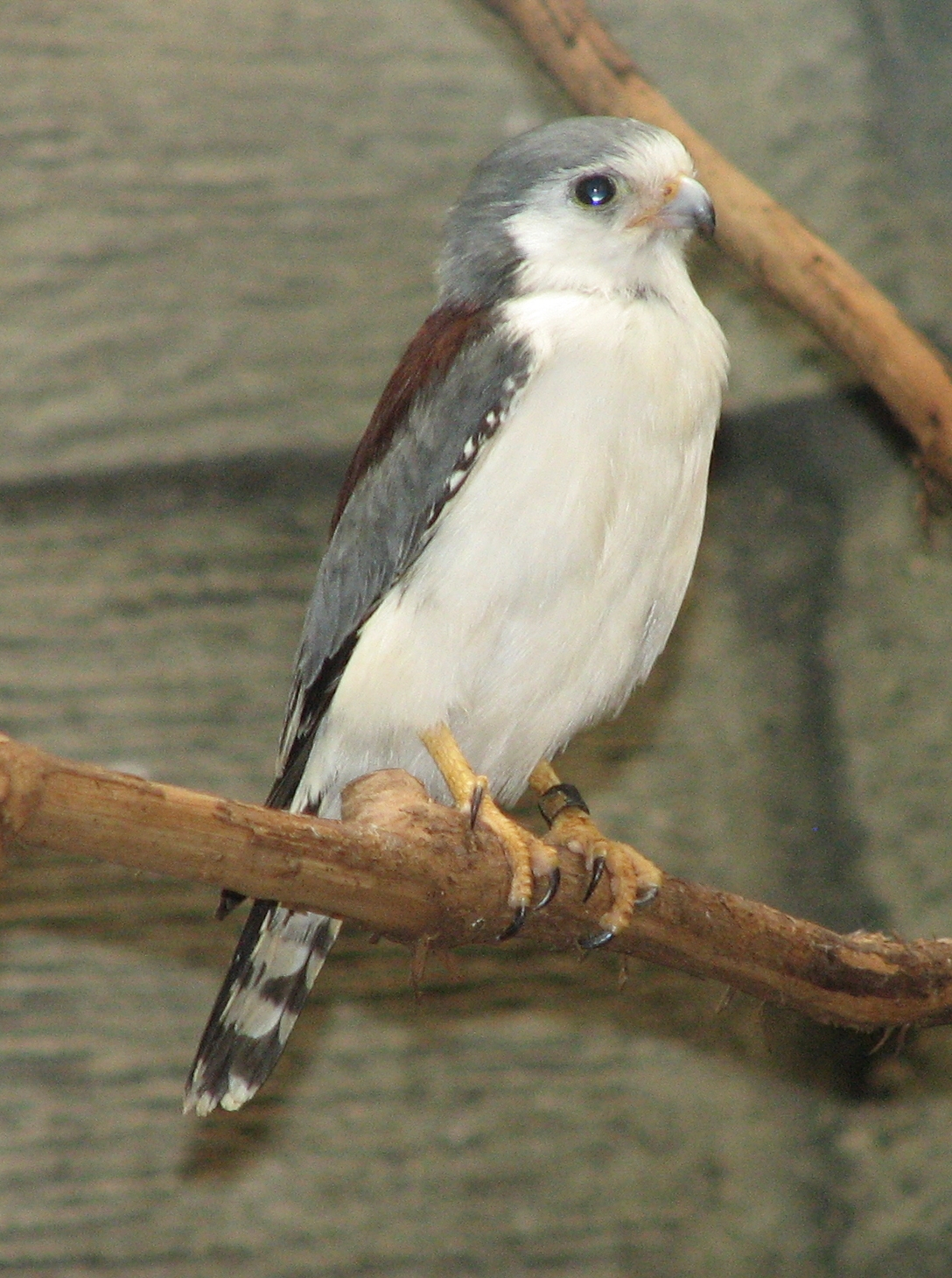- African Pygmy-falcon
Taxobox
name = African Pygmy-falcon
status = LC | status_system = IUCN3.1

image_width = 200px
regnum =Animal ia
phylum = Chordata
classis = Aves
ordo =Falconiformes
familia =Falconidae
genus = "Polihierax "
species = "P. semitorquatus"
binomial = "Polihierax semitorquatus"
binomial_authority = (Smith, 1836)The African Pygmy-falcon ("Polihierax semitorquatus") is a
falcon that lives in eastern and southernAfrica , the smallestraptor of the continent. As a small falcon, only 19 to 20 cm long, it preys on insects, small reptiles and even small mammals.Description
Adult African Pygmy-falcons are white below and on the face, grey above, the female having a chestnut back.There are white "eye spots" on the nape. Juveniles have a brown back, duller than adult females, and a rufous wash on the breast. The flight feathers of the wings are spotted black and white (more black above, more white below); the tail is barred black and white.cite book | author = Zimmerman, Dale A.; Turner, Donald A.; and Pearson, David J. | year = 1999 | title = Birds of Kenya and Northern Tanzania | publisher = Princeton University Press | pages = 90–91, 110–111, 309 | id = ISBN 0-691-01022-6 | url = http://www.amazon.com/Birds-Kenya-Northern-Tanzania-Field/dp/0713663057/ref=sr_1_1/103-7769821-1663055?ie=UTF8&s=books&qid=1185557975&sr=8-1 | accessdate = 2007-07-26] cite book | author = Sinclair, Ian; Hockey, Phil; and Tarboton, Warwick | year = 2002 | title = Birds of Southern Africa | publisher = Princeton University Press | pages = 116, 132 | id = ISBN 0-691-09862-1 | url = http://www.amazon.com/gp/reader/0691096821/ref=sib_dp_pt/103-7769821-1663055#reader-link | accessdate = 2007-07-26]
The flight is low and undulating. In size, pattern, and the habit of perching upright on an exposed branch or treetop, this species resembles some
shrike s.The call is "a high-pitched "kikiKIK", repeated" (Kenya) or "a 'chip-chip' and a 'kik-kik-kik-kik'" (southern Africa).
Range, habitat, and population
The African Pygmy-falcon inhabits dry bush. The subspecies "P. s. castanonotus" occurs from
Sudan toSomalia and south toUganda andTanzania ; "P. s. semitorquatus" occurs fromAngola to northernSouth Africa .IUCN2006|assessors=BirdLife International|year=2004|id=49486|title=Polihierax semitorquatus|downloaded=12 May 2006 Database entry includes justification for why this species is of least concern.] This range is estimated to have an area of 2.7 million km2, and the total population is estimated to be between 100,000 and 1 million birds.Nesting
In Kenya, African Pygmy-falcon nest in
White-headed Buffalo-weaver nests, and the ranges of the two birds coincide. In southern Africa, they are found aroundRed-billed Buffalo-weaver nests but predominantly nest in the vacant rooms ofSociable Weaver nests, which are large and multichambered—even if the Sociable Weavers still have an active colony in the nest. Despite being bird-eaters and bigger than Sociable Weavers, the Pygmy-falcons largely leave the latter alone, though they do occasionally catch and eat nestlings and even adults.cite journal | author = Covas, Rita; Huyser, Onno; and Doutrelant, Claire | journal = Ostrich | year = 2004 | volume = 75 | issue = 4 | pages = 325–326 | title = Pygmy Falcon predation of nestlings of their obligate host, the Sociable Weaver | id = ISSN 0030–6525]Polyandry
African Pygmy-falcons occasionally engage in polyandrous relationships, where there are more than two adults living together and tending nestlings. There are four potential reasons for this behavior: defense, co-operative polyandry, delayed dispersal of offspring, and thermoregulation (warmth). Corroboration for the last is that in winter African Pygmy-falcons nest further inside the nest of Sociable Weavers, where there is better insulation.cite journal | author = Spottiswoode, Claire; Herrmann, Eric; Rasa, O. Anne E.; and Sapsford, Colin W. | journal = Ostrich | year = 2004 | volume = 75 | issue = 4 | pages = 322–324 | title = Co-operative breeding in the Pygmy Falcon "Polihierax semitorquatus" | id = ISSN 0030-6525]
References
External links
* [http://home.hccnet.nl/r.goedegebuur/roofvog/afrikaansehalsbandvalke.html Birds Of Prey]
Wikimedia Foundation. 2010.
